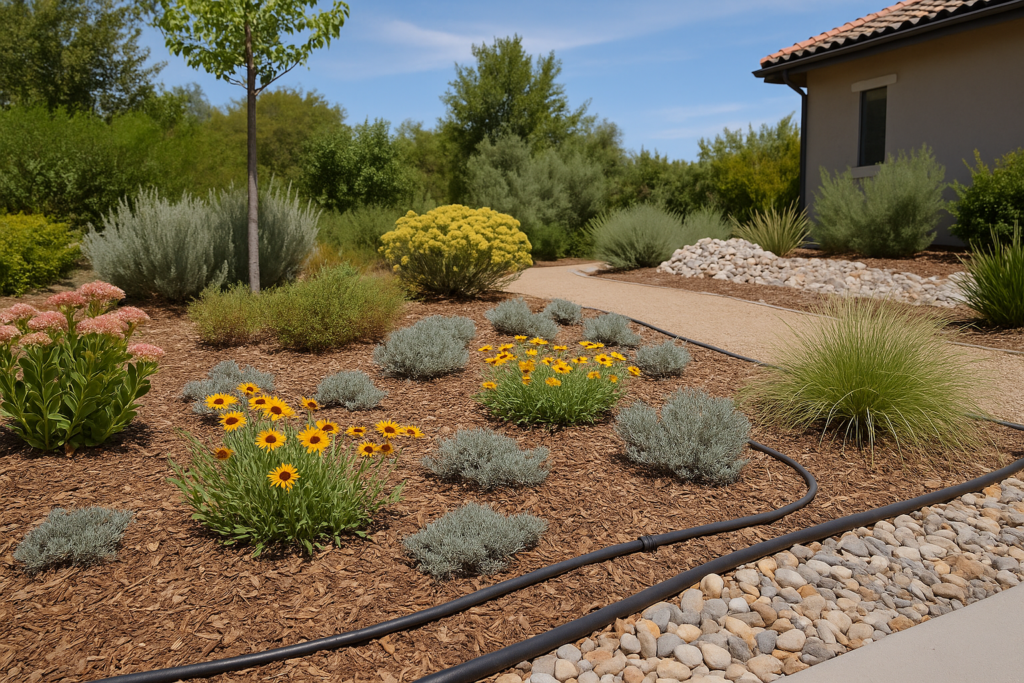As water scarcity becomes an increasing concern across many regions, homeowners and property managers are turning to innovative landscaping strategies that minimize water usage without sacrificing beauty. Bright View Landscape has become a leader in sustainable, low-water design, offering plant selections, irrigation solutions, and maintenance practices that help gardens thrive under drought conditions while remaining visually appealing year-round.
By focusing on native and drought-tolerant plants, efficient irrigation, and climate-adapted layouts, a low-water landscape not only saves resources but also supports local biodiversity and reduces maintenance costs.
Why Choose a Low-Water Landscape?
Eco-Friendly and Cost-Effective
Switching to low-water plants and modern irrigation systems can reduce water use by up to 70% compared to traditional landscaping. This translates into lower utility bills and reduced strain on community water resources. Systems like drip irrigation deliver water directly to plant roots, cutting waste and ensuring healthier growth.
Climate-Resilient Design
Low-water gardens, especially those featuring native plants, are better adapted to local weather patterns. They can handle extreme heat, withstand drought, and recover quickly after dry periods. This resilience makes them perfect for regions facing water restrictions or unpredictable rainfall.
Selecting the Right Drought-Tolerant Plants
Native Plants First
Native species thrive with minimal irrigation and maintenance, as they’re naturally adapted to local soil and climate conditions. For example:
- California sagebrush (Artemisia californica) – Attractive silvery foliage, aromatic, and resilient in coastal climates.
- California buckwheat (Eriogonum fasciculatum) – Supports pollinators and resists poor soil conditions.
Colorful, Low-Water Performers
Plants like salvia, echinacea, and blanket flowers bring vibrant colors and attract pollinators while needing little water. Succulents like sedum offer texture, seasonal blooms, and fire resistance.
Deep-Rooted Survivors
Grasses such as Russian wildrye can send roots more than 3 meters deep, accessing underground moisture and rebounding quickly after drought.
Designing with Water Efficiency in Mind
Zoning by Water Needs
Grouping plants according to their water requirements allows for more precise irrigation. Drought-tolerant zones can be watered less frequently, while higher-demand plants, such as young fruit trees, get targeted care.
Mulching for Moisture Retention
Applying 2–3 inches of organic mulch around plant bases reduces evaporation, regulates soil temperature, and suppresses weeds.
Creating Microclimates
Strategically using shade trees, rock beds, and windbreaks helps protect sensitive plants, cool soil, and reduce overall water demand.
Efficient Irrigation Solutions
Why Drip Irrigation is Ideal
Drip irrigation directs water to the root zone, minimizing evaporation and runoff. Compared to traditional sprinklers, it prevents leaf wetness (reducing disease) and delivers consistent moisture to drought-adapted plants.
Installation Tips
- Drip tape works well for annual beds and long rows.
- Soaker drip lines are perfect for shrubs and perennials.
- Pressure regulators and filters keep systems running efficiently.
Regularly flushing lines and inspecting emitters prevents blockages and ensures your system remains water-wise.
Seasonal Low-Water Gardening Practices
- Spring: Deep-water before the dry season and apply fresh mulch.
- Summer: Water early in the morning, extend intervals between watering, and monitor soil moisture.
- Fall: Reduce watering as rainfall returns; plant new natives for spring growth.
- Winter: Shut off and drain irrigation systems in frost-prone areas.
Fire-Wise Landscaping Benefits
Low-water landscaping with fire-resistant plants can help protect homes in wildfire-prone regions. Non-combustible hardscaping, gravel pathways, and well-spaced, moisture-rich plants create defensible zones.
Sustainable Landscaping and Bright View Landscape’s Role
Bright View Landscape integrates low-water plantings with other sustainable design elements such as:
- Native wildlife support – See Bright View Landscape | Sustainable Gardens Supporting Local Wildlife.
- Environmentally friendly methods – Learn more in Bright View Landscape Sustainable Design Techniques.
- Comprehensive green solutions – Read Bright View Landscape | Sustainable Landscaping for a Greener Future.
Practical Extras for a Modern Low-Water Landscape
While plants and irrigation are central, thoughtful use of materials and complementary design choices can further enhance sustainability:
- Natural stone features – For pathways, seating, or accents, a skilled stone fabricator can create durable, eco-friendly designs.
- Custom countertops and surfaces – Outdoor kitchens or garden prep stations benefit from expert Countertop Fabricator craftsmanship.
- Energy-efficient glass installations – Use the Insulating Glass Unit Guide for Architects and Builders to create garden rooms or greenhouses that conserve energy.
Conclusion
Low-water landscaping is more than just a response to drought—it’s a long-term strategy for creating beautiful, resilient, and eco-friendly outdoor spaces. With expert plant selection, efficient irrigation, and climate-appropriate design, Bright View Landscape proves that sustainability and style can go hand in hand.
By adopting these principles, you’re not only conserving water and lowering costs but also building a garden that thrives in harmony with the environment.

